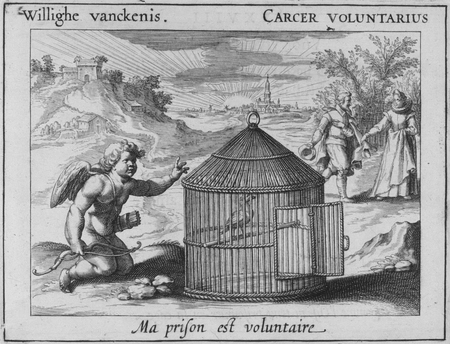Pieter Cornelisz. Hooft, Emblemata amatoria (1611)
Table of contents ↑VVillighe vanckenis [27]

Translations
 |
Vrijwillige kerkekring.
|
 |
Voluntary jail.
|
 |
Mijn kerker niet gesloten: ’t wijde luchtruim staat mij vrij.
Ik weiger. Vrijheid is voor mij: in deze kerker leven. |
 |
When the jail is not closed,
the vast space of the air is open to me.
I do not want it. My freedom is to be imprisoned. |
 |
Mijn gevangenschap is vrijwillig.
|
 |
Al staat zijn kooi ook open, de Papegaai verlaat ze niet,
Zo ook is mijn vrijheid gelegen in Liefdesslavernij. |
Sources and parallels
-
Parallel (and probably source) for the pictura and entire emblem: Perch’ io stesso mi strinsi [21]
 (in: Daniël Heinsius, Quaeris quid sit Amor (c. 1601)
(in: Daniël Heinsius, Quaeris quid sit Amor (c. 1601) )
[Compare
)
[Compare ]
]
-
Parallel (and probably source) for the pictura and entire emblem: Perch’ io stesso mi strinsi [21]
 (in: Daniël Heinsius, Emblemata amatoria (1607/8)
(in: Daniël Heinsius, Emblemata amatoria (1607/8) )
[Compare
)
[Compare ]
]
-
Parallel for the main pictorial element: Amissa libertate laetior. [13]
 (in: Jacob Cats, Proteus (1618)
(in: Jacob Cats, Proteus (1618) )
[Compare
)
[Compare ]
]
-
The Dutch motto and subscriptio inspired Bredero in:Sic vincior ultro [2]
 (in: anonymous, Thronus cupidinis (1620)
(in: anonymous, Thronus cupidinis (1620) )
[Compare
)
[Compare ]
]
-
Parallel for the main pictorial element in:Amissa libertate laetior. [14]
 (in: Jacob Cats, Sinne- en minnebeelden (1627)
(in: Jacob Cats, Sinne- en minnebeelden (1627) )
[Compare
)
[Compare ]
]
References, across this site, to this page:
- Amissa libertate laetior. [13]
 (in: Jacob Cats, Proteus (1618)
(in: Jacob Cats, Proteus (1618) )
)
- Amissa libertate laetior. [14]
 (in: Jacob Cats, Sinne- en minnebeelden (1627)
(in: Jacob Cats, Sinne- en minnebeelden (1627) )
)
- Perch’ io stesso mi strinsi [21]
 (in: Daniël Heinsius, Quaeris quid sit Amor (c. 1601)
(in: Daniël Heinsius, Quaeris quid sit Amor (c. 1601) )
)
- Perch’ io stesso mi strinsi [21]
 (in: Daniël Heinsius, Emblemata amatoria (1607/8)
(in: Daniël Heinsius, Emblemata amatoria (1607/8) )
)
- Sic vincior ultro [2]
 (in: anonymous, Thronus cupidinis (1620)
(in: anonymous, Thronus cupidinis (1620) )
)

